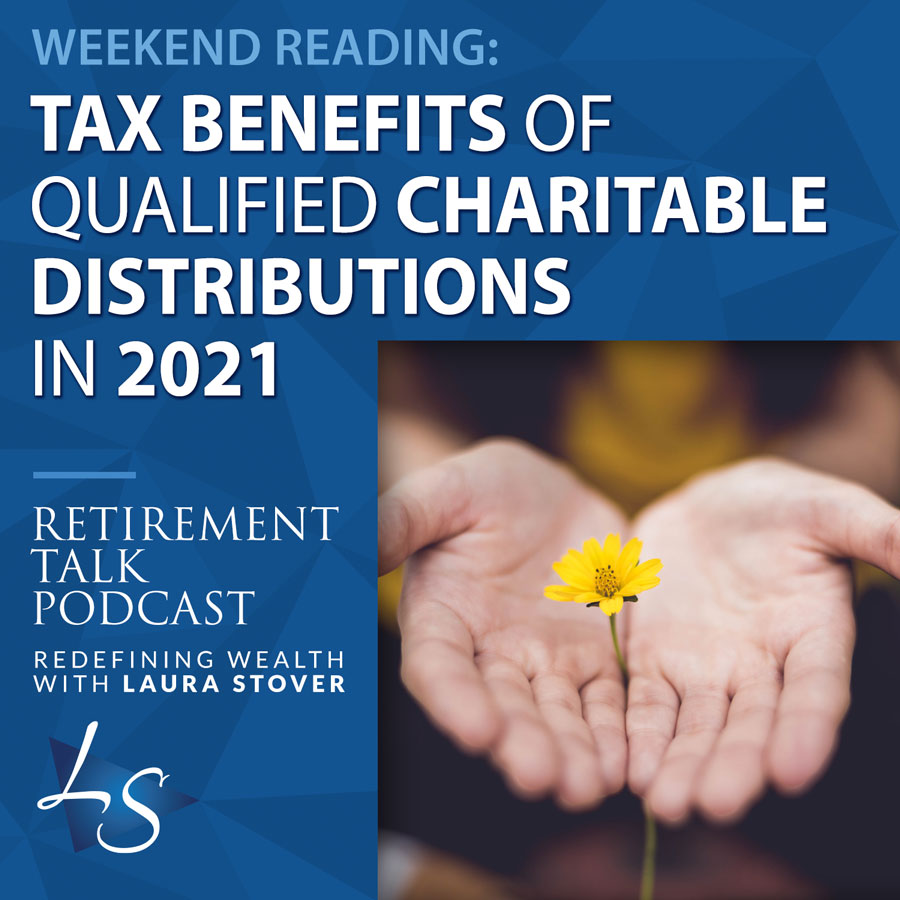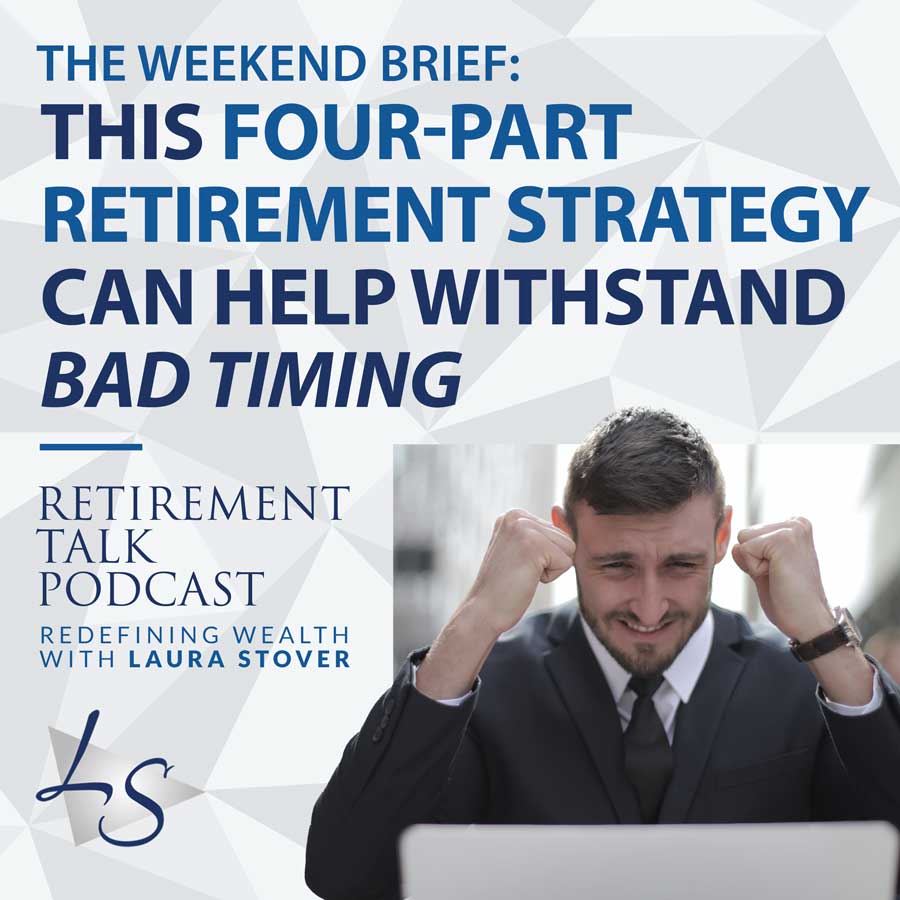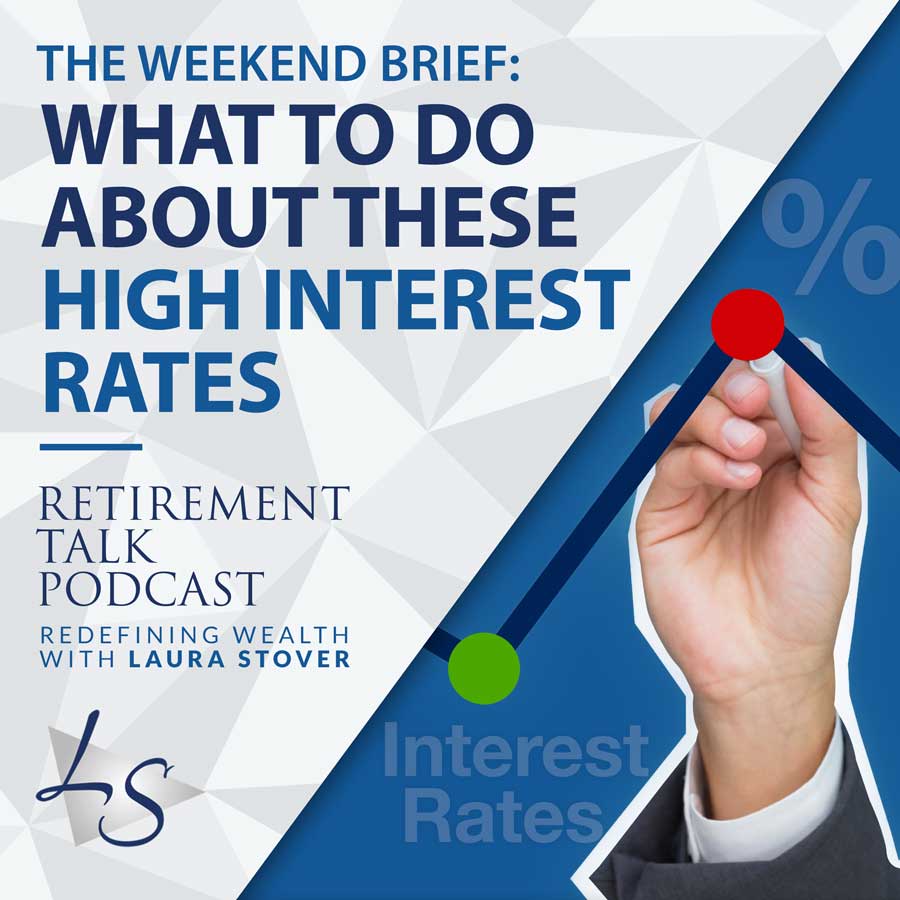In 2021, we’ve been presented with a unique opportunity to maximize Qualified Charitable Distribution tax benefits! Due to the CARES Act and the COVID Related Tax Relief Act of 2020, this is your last chance to make unlimited contributions from your IRA to charity! In this episode, Laura discusses how this contribution works and what you need to know in order to take advantage of this opportunity.
Review the article mentioned in today’s show >>
Rate & Review the Podcast on your favorite podcast app!
Sign Up for The Weekend Reading Email to read more on the featured podcast: redefiningwealth.info/weekend-reading
Show Notes
Intro (:11)
Weekend Read (1:40)
Supply Shortages (2:20)
Two Types of Inflation (2:42)
1. Demand Growing Faster than the Economy’s Productive Capacity (Linked to a Strong Economy)
- Constricted Supply, Ultimately Curtail Output, Driving Up the Prices and Eroding Incomes (Linked to Weaker Economy)
US Department of Labor: Reported Inflation Grew at the Fastest Pace in 13 Years (3:27)
What’s Driving Inflation (6:20)
The Treasury Yield (7:30)
Text KNOWLEDGE to 474747 to Ask Laura Anything (10:10)
Tax Benefits of a Qualified Charitable Distribution (10:38)
Traditional IRA Benefits (11:43)
- Ability to Invest Pre-Tax Dollars
- You Don’t Pay Tax on Your Investments Until the Time You Begin Taking the Income at Age 59.5
Unlimited Charitable Giving in 2021 – Final Year (12:25)
QCD’s – Normal Limit is $100,000 (This Year is Unlimited)
Qualified Charitable Distribution Tax Benefit (13:06)
A qualified charitable distribution is a tax benefit that allows some owners of individual retirement accounts to use their IRA, to make a charitable contribution directly from transferring IRA funds to qualifying charities. The IRA funds that go to the charity are then excluded from your income.
CARES Act & COVID Related Tax Relief Act of 2020 (16:36)
Impacts of Itemized Deductions (17:50)
Mega QCD Benefit: the ability to reduce taxable retirement account balances at a 0% tax rate by using these funds to make charitable gifts. (20:21)
Links:
Weekend Read: redefiningwealth.info/weekend-reading
Text KNOWLEDGE to 474747
Text TAX GUIDE to 474747
Last Week’s Episode: Deconstructing the Complexities of Decumulation in Retirement
Listen & Subscribe
JAG:
Welcome to Retirement Talk, the Redefining Wealth Show, specifically for pre-retirees and retirees to help you better understand and navigate during these financial times. We’re here to discuss thoughts and ideas with some of today’s foremost experts in the field of finance and retirement, as well as discuss trending topics that could impact your bottom line. These discussions can help you make better financial decisions and be informed so you can live the lifestyle you imagined and make better financial choices. Laura Stover is a registered financial consultant and CEO of LS Wealth Management, as well as founder and owner of LS Tax, a consulting firm. She’s been featured in Forbes, CNBC, and The Wall Street Journal. I’m John JAG Gay, here is your host for Retirement Talk, Redefining Wealth, Laura Stover.
Laura:
Hey, hey, hey, hello JAG. How are you doing today?
JAG:
We are good to go. Ready to get in today’s topic.
Laura:
And we hope to have Mr. Michael back with us soon, but we are here to talk about finance news and your retirement, and boy JAG, there is a lot for the week that transpired, so much to talk about. As I am searching through articles week after week to find the perfect one to highlight for each and every show that I think is the most important for people to be in the now about, I came across a great article that we are going to highlight today that hopefully could save you some tax money. That’s right. You heard it straight from Retirement Talk, save you some tax money, but you have to act quickly because time is running out. And before we get to that featured article though, if you want to read more on it, simply go to redefining wealth.info, sign up and subscribe for free to the Weekend Read. I’ll send you four articles, including the show article that we are featuring each and every week, that will come straight to your inbox on Fridays. Sign up for that, again, go to redefining wealth.info.
Laura:
And before we hop into that featured article, JAG, I have been asked a lot of questions, a lot of questions have come into the show and I do think it is prudent to discuss a few concerns that people definitely have. I paid almost $10 for a bag of my favorite raw almonds this past week, there is definitely some supply shortages. I’m seeing some empty shelves in some of the big retail stores. Prices, I keep running in looking for some of my favorite things, nowhere to be found for weeks. And everyone is wondering what about this inflation thing? And I want to just talk about this real quick. There’s two kinds of inflation, one results from demand growing faster than the economy’s productive capacity causing the economy to overheat. And that’s really a good type of inflation.
JAG:
And we call it good inflation because it’s usually linked to a stronger economy.
Laura:
Correct. And by contrast though, bad inflation results from constricted supply, which will ultimately curtail output, driving up the prices and eroding incomes leading to a weaker economy. And unfortunately we’re kind of in the latter and I’ll tell you why here shortly.
JAG:
Yeah, it’s not surprising you’re getting a lot of questions about this Laura because the US Department of Labor just reported inflation grew at the fastest pace in 13 years. In fact, prices at wholesale went up 7.3% from last year, highest jump in the department’s 11 year history of record keeping. So I want to talk to you about this, Laura, because you always make me and our listeners feel better. Is it starting to feel like more than just a blip? What do you think about the idea that inflation could be here to stay?
Laura:
I originally thought it was here to stay. I mean, once people are charging higher prices, why do you want to go back down if you’ve embedded that in? I think a lot of economist and money managers, I highly respect though their consensus is that it’s not here to stay. So I was a little appeased hearing some of their contention on this. It’s a part of a compressed, rapid recovery that we’ve had if we put it all into context and we’re going through the fastest part of that recovery now. I think maybe in fact, we’re already past that point already. And remember the data is looking in the rear view mirror when it comes out. So we’re heading up to a spot where the stimulus effects, that’s what’s actually fading and it’s fading really fast. Now I’m not suggesting we need trillions of more dollars in, but this is a result of all of that stimulus now kind of tapering off.
Laura:
So looking ahead, we’re not going to have the same level of stimulus coming into the market, helping the markets, helping those asset prices, you still have a high level of unemployment, open jobs. I see bonuses offered everywhere trying to hire people. So this has to calibrate before we continue pressure on inflation. So really the risk is that inflation comes down much lower than expected. And that’s what I think is a real possibility here as we head into the latter part, we’re almost over halfway through 2021 already.
JAG:
More than halfway through. Yeah.
Laura:
Get me on your Christmas list. Plenty of time to start that shopping now. But if we look into 2022, a little bit early and start to react accordingly, I think we’ll see a fast, slow down in China that really hasn’t hit the market yet. And thanks to what we call credit contraction, meaning loans aren’t expanding, they’re actually contracting. I think that’s a little bit of a concern on the radar that has not really been talked about, or addressed in the media or in the investment landscape as a whole.
JAG:
And that’s why we’re talking about it. And that’s why we have these conversations Laura. Nobody else really does. Okay. So questions. Let’s take a look at what’s driving inflation here because I thought this was really interesting. Top of the list of course, used car and trucks. Again, I’m [inaudible 00:06:28] in Detroit, my wife works in automotive. So I understand this. These prices of used cars and trucks have increased 10.5% month to month. That’s scary for people who are home and again, trying to stay on a budget. Does this mean anything? Does it really matter to you from where you sit?
Laura:
I think again, it’s an acute challenging you only reopen once, hopefully we only go through a pandemic once. So when we’re reopening here, we had some supply challenges, in particular with semiconductors and new cars, new cars need those semiconductors there in the Motown and that’s basically left a void in the supply chain. So the used car market had an uptick to fill that void. We saw a surge in demand just because you couldn’t have access to new cars. So there’s limited supply on those dealer lots.
JAG:
Right, and we’re seeing a news story where they had all these brand new cars sitting on a lot that were useless because they didn’t have the computer chips they needed because of the semiconductor shortage. So that’s why the used car market went up, as you said. Okay, last thing I want to ask you about Laura. On the latest news, this one was actually confusing to me, which was of course the treasury yield. I know this is your wheelhouse. You can explain it better than me. Tell me what we’re looking at here, because I know that everybody was losing their minds because the 10 year treasury year to date, you can see it’s been kind of increasing, then hit that magic number of 1.4%. What does that mean? And why is 1.4% so significant?
Laura:
Well really that was a low that occurred prior to the pandemic. So we hit a yield low and that was at the 1.4%. Then it started to fade and move higher from there, expecting higher growth. Then the pandemic hit, then the yields all were driven lower. So what happens during a pandemic or any type of crisis, yields will go lower, meaning there’s a rush to buy bonds. So yields are inversely correlated with the price of bonds. When the price goes up, yields go down. Usually it’s showing that either investors think there’s going to be lower inflation or lower growth. So they’re scared of something and it’s kind of a fear move in there, I think, what’s moving right now is that the market doesn’t think inflation is here to stay. And that’s why you see the 1.4% on the treasury, in the end, that 10 year treasury is an extremely important number, it’s an economic because it prices all other risk assets in the market.
Laura:
It prices mortgages, the equity risk premium for stocks, meaning how much return you expect above that and what they consider a risk-free rate in the 10 year treasury yield is very important. That’s an important yield and an important number to keep an eye on, particularly for professionals, but it always affects everybody. So 1.4 and going lower is very low. It’s also telling you that, well, gee, maybe growth is really starting to slow much quicker than anybody anticipated and the market, the bond market is usually right. And even though it doesn’t get all the media attention, there’s a lot of information in that yield. And we saw a lot of distress on fixed income the first quarter. So if you held individual bonds with your broker, you saw some big declines, and that’s why we do things a little different here.
JAG:
Right. Meanwhile, economic data has gone from solidly upbeat to mixed. In the news, we’re keeping an eye on these evolving circumstances, it’s top of mind for our listeners. Those who’ve retired, or they’d like to, at some point, if you have a question for Laura about this, you can text into the show. You can communicate by texting the word knowledge to 474747. Again, knowledge to 474747. Ask anything and you might hear your question answered here on the show. Laura, today’s featured article is some tax moves a person could make, but they need to do it in 2021. Let’s strive for some good news. We’ll pivot here a little bit. Good moves tax benefits. We’re always up for that. Let’s talk about today’s featured article from the Weekend Read, tax benefits of a qualified charitable distribution.
Laura:
Well I’m always loving to talk about tax, and I think so many people miscalculate the importance of a proactive plan. They think, oh, I’m just going to do a Roth conversion, I’m doing the conversions, that’s all I need to do, I’m contributing to an HSA. Those things are all fantastic, but some smart tax tips. And again, we use a qualified CPA, LS Tax has a qualified CPA, always converse with a CPA to see what’s in your best interest, but some tips. Using a traditional IRA to maximize your charitable impact now, even if you are per se, not a charitable type of person, you can still do this and implement the idea.
Laura:
So if you are near or in retirement, you’ve been saving some money like most people in those large IRAs, they grow tax advantaged, they’re tax deferred, that’s a way to save money over the years. And obviously the key benefits offered by the traditional IRA are two-fold. The ability to invest pre tax dollars, and this is a little debatable, I believe because of the strong likelihood we are in fact, going to be moving to a period of much higher taxation. I think that, I can promise you that.
Laura:
And secondly, you don’t pay tax on your investments until the time you begin taking the income, which you can do by age 59.5 at the earliest, or you get that tax penalty. So as a charitably minded owner of a traditional IRA, you may want to consider using tax smart tips to help maximize tax deductions. As a big part of this, I’m going to explain it is only available this year. Well, you can do it every year, but it’s much better here in 2021. So 2021 is the last year you can use your retirement funds for unlimited charitable giving. That’s the big caveat. Typically for QCDs as we abbreviate qualified charitable distributions, bill limits like 100,000 a year. Right now it’s unlimited because of the CARES act and all these acts they’ve passed. So this is a big opportunity.
JAG:
Yeah, most people no longer receive tax benefits for their charitable gifts because they take the standard deduction and they don’t itemize, but this could be a little bit different, right?
Laura:
A qualified charitable distribution is a tax benefit that allows some owners of individual retirement accounts to use their IRA, to make a charitable contribution directly from transferring IRA funds to qualifying charities. The IRA funds that go to the charity are then excluded from your income. So JAG that exclusion from income provides a better tax benefit than an itemized deduction in most cases, because the QCD reduces the person’s adjusted gross income.
JAG:
That makes sense at AGI, because IRAs are the best funds to give to charity since these funds are generally pre-tax.
Laura:
Well, yes, and the QCD provision allows the IRA funds to be withdrawn at a 0, I said 0, 0% tax rate and can offset the income from a required minimum distribution. So that’s really a key part of the really cool part of this. We have a lot of clients taking advantage of this, this year. I don’t think many people know about it as far as the unlimited amount that you can contribute this year. So the foundation of all good tax planning, we always tell clients is to always pay taxes at the lowest rate. So any time a taxable IRA fund could be moved from the account without tax, that’s certainly an opportunity, and you should take advantage of it. QCDs allow that to be done, I think it should be maximized for anybody making charitable gifts in particular.
JAG:
Yeah, QCDs do have their limitations. They’re only available to IRA owners and IRA beneficiaries who are 70.5 or older. And they’re limited to 100,000 per person per year, not per IRA account, it’s per person. And they are primitive from company plans like 401ks or 43Bs.
Laura:
Right. You can’t take it from your employer plan. And again, that’s typically the rule, but this year for 2021, the big news flashing, you heard it here. The qualified charitable distribution is a benefit that can be greatly expanded because of provisions to recent tax laws. And is a great opportunity to do what I call a mega QCD because it is not limited to the $100,000 limitation normally that we have. I mean 100,000 is still a pretty lenient number, but unlimited is even better.
JAG:
We hope you’re enjoying Retirement Talk, the Redefining Wealth Show. If you’d like to learn more on our featured article for today, you can subscribe to the Weekend Read. Sign up for free. Just go to redefining wealth.info and click on subscribe. The LS team wants you to make the best decisions for your financial future. Learn more about today’s topic and tax changes. You can text the word tax guide to 474747. Once again, that is tax guide to 474747. Position your portfolio for managing volatility better, understand where you are with your risk tolerance, schedule a 15 minute strategy session, go to redefining wealth.info and click schedule. Now back to Retirement Talk with your host, Laura Stover.
Laura:
So a little more detail JAG in terms of how this works on the QCDs with unlimited charitable distributions that can potentially really give some people a tremendous tax benefit. We call it a mega tax benefit for this year. Here’s how it works just a little bit and who could benefit. Well, the adjusted gross income limit on tax deductions for cash gifts to charity, that’s currently 100%, but that ends at the end of this year as well. So the CARES Act eliminated the prior 60% of the AGI limit for 2020, and the COVID Related Tax Relief Act of 2020, enacted late in 2020 in fact, that extended this benefit through the end of 2021, resulting in tax deductions of up to 100% of the adjusted gross income for any type of cash gift. So essentially what do the QCDs have to do with that?
Laura:
Well, nothing directly, but the result, if you combine these two provisions, that could create what I call a mega QCD opportunity, allowing unlimited distributions from any retirement account, not just IRAs, to be given to a charity for 100% tax deduction for those itemizing deductions. And again, we would go through our CPA, at LS Tax, that’s a complimentary service through our LS Wealth Management clients. I encourage anyone listening that is interested in this idea to reach out to us. We’re happy to give you a no obligation opinion on that, to see if you would benefit from this or speak with your CPA by all means, and your financial advisor. But a large charitable tax deduction, that can also allow more people to itemized deductions, and when those itemized deductions exceed that standard deduction amount, that in turn would free up other itemized deductions like your state or local tax, your mortgage interest to be claimed and increasing your overall tax benefits.
Laura:
So if you have a large IRA and you wish to use those funds to make a large charitable gift, let’s say you withdraw million dollars from an IRA, you give that million dollars to a qualified charity, then you receive a million dollar tax deduction completely offsetting the income on the entire one million distribution from the IRA.
Laura:
Now the downside, this would naturally increase your adjusted gross income, which could reduce or eliminate certain AGI base tax deductions, credits, other benefits. Those deductions for medical expenses could also be greatly reduced. So you want to, again, consult with someone that knows their tax laws and the financial planning aspect of this. You could also see deductions, they could be limited to amounts in excess of 7.5% of AGI, that Medicare, IRMAA surcharge, IRMAA’s not a good aunt to having your life, for parts B and D on Medicare. And taxation of social security benefits could also be increased. But I think the overall tax planning picture, these items may be insignificant, you kind of have to weigh it out if you’re a high net worth or high income individual, and you wish to gain some benefits for large charitable gifts.
JAG:
As we always say, it depends on your individual situation and then Laura, the ability to use unlimited amounts of funds in IRAs or company plans to give to charity and receive a 100% deduction or up to a 100% of your AGI would be a huge tax benefit for those who would normally make large charitable gifts, but aren’t able to maximize the tax benefits.
Laura:
Yeah, and I think who really would benefit the most, I mean, generally what I call this mega QCD is going to be valuable to those, if you don’t qualify for a QCD, because you’re either under the age of 70.5, or you want to use your 401k, if eligible for a plan withdrawal for making charitable gifts, or maybe you’d like to give more than the annual 100,000 in that QCD limit, 401k and IRA beneficiaries could benefit as well. So the big picture tax benefit of this mega QCD is the ability to reduce taxable retirement account balances at a 0% tax rate by using these funds to make charitable gifts.
JAG:
This will bode well in the future if tax rates increase on these growing IRA and 401k balances, which as you said earlier, and have said a lot, is likely.
Laura:
Well it’s a double tax benefit using the QCD and the mega QCD. If you qualify, the QCD can still use that for IRA transfers up to the 100,000 limit and then use the mega QCD to make gifts in excess of that amount. So while a QCD can offset the tax on an RMD, required minimum distribution, and exclude that from the adjusted gross income, using the mega QCD does not. However corresponding itemized deductions for the charitable contribution could still offset the tax on, well let’s say an IRA or a 401k distribution. Now don’t use the mega QCD if you’re under the age of 59.5, that could trigger the 10% early distribution penalty. Again, consult with a qualified CPA for your unique and specific situation. Don’t use Roth funds since there’s no tax benefit to be gained. That seems like a … But every time I turn around, someone’s doing something that they shouldn’t. No, those Roth distributions will generally be tax-free so you don’t want to use those.
JAG:
That’s a really good point, Laura. The tax taxes on the Roth are paid in the way in and the way out. So there are no taxes that you’re trying to avoid on the way up because you pay the tax on the way in on the Roth.
Laura:
Right, and be aware that the 100% of the adjusted gross income limit for deducting cash gifts to charities doesn’t apply to donor advised funds or gifts to other supporting organizations. So this truly is a novel tax benefit, it’s only going to be available for the rest of 2021. Basically you use it or lose it. So again, a proactive tax plan, that is one of the key pillars to the Redefining Wealth process, that’s our proprietary process, that everyone needs to focus on the five pillars of financial planning. Each pillar is paramount. In last week’s show JAG, we talked about de-accumulation. Everyone focuses on saving and accumulating through retirement. Well, now you’re in a different category. If you have saved a large sum of money, you’re wanting to retire in the near future, and I call that any time, 10 years or less. That’s really not a large window to make sure you have proper planning in place.
Laura:
I just spoke with a listener a couple of days ago. Thank you for everyone who’s listening and calling in and wanting to take a moment and speak with me. He wants to retire in five years, he’s done very well. He’s been an aggressive investor, but no tax planning. So you can save millions of dollars through your lifetime if you’re blessed to save that much and have a nice nest egg. But without a proper plan on how to take income, which assets to withdraw from first, how the taxation will affect those income distributions when you’re needing them. A lot goes in that income, no matter how much you have accumulated in assets, everybody needs a withdrawal plan.
Laura:
In other words, how are we taking money out of these accounts at various points in times. That five pillars of risk income, investment management, making sure we’re not losing dollars within our capital. There’s a difference in how we construct money management with the blend of tactical and strategic, not just buy and hold, because again, we’re at this decumulation phase. We don’t want our retirement dollars to go backwards. We want it to be able to geometrically compound during times of volatility. And if we’re taking dollars out of that investment portfolio, during those times of volatility, we have to have the structure and the framework in alignment with the goals, the purpose of our money. It sounds simple articulating, but a lot of time goes into that written plan, our proprietary process with the redefining wealth process. Make sure that the health care, the tax, is all embedded into the retirement plan so you can live the lifestyle you imagine.
JAG:
Laura, that goes back to what we were talking about last week is, anybody can help you with your investments and figure out how to grow your money while you’re still working and you’re in that accumulation phase. But like we said, you need to plan for the de-accumulation phase, you need a plan for once you’ve retired, how to spend down that money and how to protect yourself against losing it or outliving your money as we say. So between that, we’ve talked about today with this almost … I don’t want to call it a loophole, but with this ability to do these charitable distributions here in 2021, it really does speak to the LS Wealth process you have at LS Wealth Management and how it really can be tailored to each individual situation and why it is so important to come talk to you and your team to plan your financial future.
Laura:
And anyone listening, I want to offer you our tax guide. Simply text, taxguide, all one word, 474747. That’s taxguide, 474747. Thank you for listening today. I hope you found the information helpful and insightful. Both the LS team and I strive to provide you with the very best resources from LS Wealth. We want to help you establish the framework necessary to sustain and obtain your retirement. I want to offer you a complimentary Redefining Wealth strategy review of your entire financial and retirement plan. I want to make sure you have the balance and plan you need in place to address changes that will most definitely occur throughout your retirement, and the different types of risk that you’ll likely face. We’ll provide a virtual, phone or in-person session. You can be confident of your financial plan. Go to redefining wealth.info, click schedule review. That’s redefiningwealth.info, click schedule review.
JAG:
For more information on today’s show, go to redefining wealth.info for show notes. You can also subscribe for free to the Weekend Read to learn more about today’s episode. When you subscribe, you’ll receive four articles each and every Friday, straight to your inbox with the most important articles during these financial times. This free subscription will provide you with valuable retirement information, as well as trending topics, along with Laura’s breakdown on what you need to know about each topic. Sign up now for the Weekend Read. Go to redefining wealth.info and click on Weekend Read. Redefining Wealth is a registered trademark of LS Wealth Management. Investing involves risk, including the potential loss of principal, any references to protection, safety, or lifetime income, generally refer to fixed insurance products, never securities or investments. Insurance guarantees are backed by the financial strength and claims paying abilities of the issuing carrier.
JAG:
This show is intended for informational purposes only. It is not intended to be used as the sole basis for financial decisions, nor should it be construed as advice designed to meet the particular needs of an individual situation. LS Wealth Management, LLC, [inaudible 00:28:01] offer, and no statement made during this show shall constitute tax or legal advice. The firm is not affiliated with or endorsed by the US government or any governmental agency. The information and opinions contained herein provided by third parties have been obtained from sources believed to be reliable, but accuracy and completeness cannot be guaranteed by LS Wealth Management, LLC. Investment advisory services offered through optimized advisory services and SEC registered investment advisor, LS Wealth Management is a separate entity.












